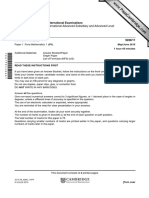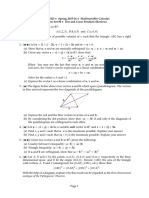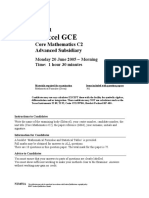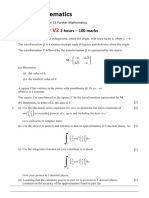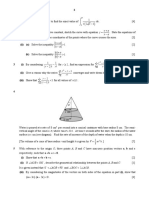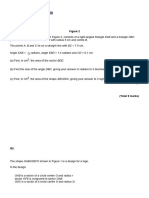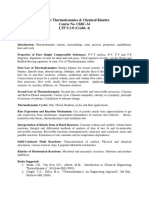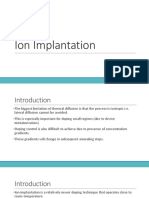WJEC2014C4
WJEC2014C4
Uploaded by
TSE TONYCopyright:
Available Formats
WJEC2014C4
WJEC2014C4
Uploaded by
TSE TONYCopyright
Available Formats
Share this document
Did you find this document useful?
Is this content inappropriate?
Copyright:
Available Formats
WJEC2014C4
WJEC2014C4
Uploaded by
TSE TONYCopyright:
Available Formats
GCE AS/A level
0976/01
MATHEMATICS – C4
Pure Mathematics
A.M. MONDAY, 16 June 2014
1 hour 30 minutes
ADDITIONAL MATERIALS
In addition to this examination paper, you will need:
• a 12 page answer book;
• a Formula Booklet;
• a calculator.
INSTRUCTIONS TO CANDIDATES
Use black ink or black ball-point pen.
Answer all questions.
Sufficient working must be shown to demonstrate the mathematical method employed.
INFORMATION FOR CANDIDATES
The number of marks is given in brackets at the end of each question or part-question.
You are reminded of the necessity for good English and orderly presentation in your answers.
© WJEC CBAC Ltd. CJ*(S14-0976-01)
2
1. The curve C is defined by
3x3 – 5xy2 + 2y4 = 15.
The point P has coordinates (1, 2) and lies on C.
Find the equation of the normal to C at P. [5]
5x 2 + 7x + 17
2. (a) Express in terms of partial fractions. [4]
( x + 1)2 ( x – 4)
(b) Use your answer to part (a) to express 5x 2 + 9x + 9 in terms of partial fractions.
( x + 1)2 ( x – 4) [2]
3. (a) Find all values of x in the range 0° X x X 180° satisfying
tan 2x = 3 cotx. [4]
(b) (i) Express 21 sin θ – 20 cos θ in the form R sin (θ – α ), where R and α are
constants with R > 0 and 0° < α < 90°.
(ii) Use your results to part (i) to find the greatest value of
1 .
21sin θ – 20 cos θ + 31
Write down a value for θ for which this greatest value occurs. [6]
4. The region R is bounded by the curve y = 3 + 2 sin x, the x-axis and the lines x = 0, x = π .
4
Find the volume of the solid generated when R is rotated through four right angles about the
x-axis. Give your answer correct to the nearest integer. [6]
5. Expand
6 1 – 2x – 1
1 + 4x
in ascending powers of x up to and including the term in x2.
State the range of values of x for which your expansion is valid. [7]
© WJEC CBAC Ltd. (0976-01)
3
6. The curve C has the parametric equations x = 2t, y = 5t 3. The point P lies on C and has
parameter p.
(a) Show that the equation of the tangent to C at the point P is
2y = 15p2x – 20p 3. [4]
(b) The tangent to C at the point P intersects C again at the point Q(2q, 5q3). Given that
p = 1, show that q satisfies the equation
q3 – 3q + 2 = 0.
Hence find the value of q. [5]
7. (a) Find
∫ x ln 2x dx .
4
[4]
(b) Use the substitution u = 10 cos x – 1 to evaluate
π
[4]
∫
3
(10 cos x – 1) sin x dx.
0
8. The value £V of a long term investment may be modelled as a continuous variable.
At time t years, the rate of increase of V is directly proportional to the value of V.
(a) Write down a differential equation satisfied by V. [1]
(b) Show that V = Aekt, where A and k are constants. [3]
(c) The value of the investment after 2 years is £292 and its value after 28 years is £637.
(i) Show that k = 0·03, correct to two decimal places.
(ii) Find the value of A correct to the nearest integer.
(iii) Find the initial value of the investment. Give your answer correct to the nearest
pound. [6]
TURN OVER
© WJEC CBAC Ltd. (0976-01)
4
9. (a) The vectors p and q are given by
p = 2i – j + 3k
and q = 5i + 4j – 8k.
Find the angle between p and q. [4]
(b) In the diagram below, the points O, A, B, C and D are such that A is the mid-point of OD
and C is the mid-point of OB.
O D
A
Taking O as the origin, the position vectors of A and B are denoted by a and b respectively.
(i)
1
Show that CD = 2a – b .
2
Hence show that the vector equation of the line CD may be expressed in the form
r = 2 λa + 1 (1 – λ ) b.
2
The vector equation of the line L may be expressed in the form
r = 1 µa + 1 ( µ – 1) b.
3 3
The lines CD and L intersect at the point E.
(ii) By giving λ and µ appropriate values, or otherwise, show that E has position
vector 2 a + 1 b .
3 3
(iii) Give a geometrical interpretation of the fact that E has position vector 2 a + 1 b .
3 3
[7]
10. Complete the following proof by contradiction to show that
sin θ + cos θ X 2
for all values of θ.
Assume that there is a value of θ for which sin θ + cos θ > 2.
Then squaring both sides, we have:
[3]
END OF PAPER
© WJEC CBAC Ltd. (0976-01)
You might also like
- Cambridge International Advanced Subsidiary and Advanced LevelDocument4 pagesCambridge International Advanced Subsidiary and Advanced Levelyousee yusiNo ratings yet
- DHS P2Document7 pagesDHS P2Bryan TangNo ratings yet
- 2018 JC2 H2 Maths SA2 Hwa Chong InstitutionDocument44 pages2018 JC2 H2 Maths SA2 Hwa Chong InstitutionZtolenstarNo ratings yet
- 2014 PureDocument20 pages2014 PuremiryanamhNo ratings yet
- Mathematics C4 Pure MathematicsDocument3 pagesMathematics C4 Pure MathematicsblackurikillermanNo ratings yet
- Problem Sets ALL PDFDocument34 pagesProblem Sets ALL PDFLeroy ChengNo ratings yet
- 2021 SPM Trial 1 A Maths (P1)Document5 pages2021 SPM Trial 1 A Maths (P1)Wong SieaLiangNo ratings yet
- 2022 H2 Math Prelim (Vectors)Document19 pages2022 H2 Math Prelim (Vectors)legacyNo ratings yet
- 3 2 4 1 - +, Showing The Coordinates of The Points Where The Curve Intersects The Coordinate Axes.Document14 pages3 2 4 1 - +, Showing The Coordinates of The Points Where The Curve Intersects The Coordinate Axes.Nirvaan PuriNo ratings yet
- Revise 3Document88 pagesRevise 3Aisha QasimNo ratings yet
- Edexcel C1 Specimen Paper Answer All Questions. Time: 1 Hour 30 MinutesDocument3 pagesEdexcel C1 Specimen Paper Answer All Questions. Time: 1 Hour 30 MinutesLaksh RameshNo ratings yet
- Gce As/A Level - New: Monday, 13 May 2019 - Afternoon Further Pure Mathematics ADocument3 pagesGce As/A Level - New: Monday, 13 May 2019 - Afternoon Further Pure Mathematics Ajack murairwaNo ratings yet
- 2021 JC1 Promo Practice Paper ADocument5 pages2021 JC1 Promo Practice Paper Avincesee85No ratings yet
- 2022feb Core Pure v2Document26 pages2022feb Core Pure v2Erlind MetajNo ratings yet
- Math T STPM Semester 1 2013Document2 pagesMath T STPM Semester 1 2013tchinhuat82No ratings yet
- DHS 9758 2023 Prelim P1Document7 pagesDHS 9758 2023 Prelim P1cyclonususNo ratings yet
- SPM2022 Actual Paper 2Document10 pagesSPM2022 Actual Paper 2soochin93No ratings yet
- 2004 India IMO Training CampDocument5 pages2004 India IMO Training CampHariPrasad PoilathNo ratings yet
- Pure Mathematics Revision Worksheet Month 8Document4 pagesPure Mathematics Revision Worksheet Month 8Le Jeu LifeNo ratings yet
- WJEC 2014 C4 MathsDocument4 pagesWJEC 2014 C4 MathsphilgiddyboyNo ratings yet
- SPM 2017Document6 pagesSPM 2017Hui JingNo ratings yet
- Practice Pure 2 2024Document34 pagesPractice Pure 2 2024bethstephens2005No ratings yet
- A Level MathsDocument50 pagesA Level MathsjessieNo ratings yet
- P2 MEGA REVISION For JAN 21 Candidates PDFDocument3 pagesP2 MEGA REVISION For JAN 21 Candidates PDFblob bleepNo ratings yet
- Jan 2005 Core 1 PaperDocument4 pagesJan 2005 Core 1 PaperNisanthJoelNo ratings yet
- Calculus 2Document70 pagesCalculus 2rushilrajmehtaNo ratings yet
- ACSIAM1Document3 pagesACSIAM1JASON_INGHAMNo ratings yet
- P1Document5 pagesP1MohPlaysNo ratings yet
- Cambridge International Advanced Subsidiary and Advanced LevelDocument4 pagesCambridge International Advanced Subsidiary and Advanced LevelDeja Vu MusicNo ratings yet
- Summer2024 MSDocument32 pagesSummer2024 MSkrrish5906No ratings yet
- DifferentiationDocument30 pagesDifferentiations2021070322No ratings yet
- QP - 0606 Mock Exam 1 Paper1 - FinalDocument10 pagesQP - 0606 Mock Exam 1 Paper1 - Finalejljn1No ratings yet
- Questionpaper UnitC2 (6664) June2005Document5 pagesQuestionpaper UnitC2 (6664) June2005Asem BarhoushNo ratings yet
- 2022feb Core Pure v2 MSDocument17 pages2022feb Core Pure v2 MSErlind MetajNo ratings yet
- Sekolah Tinggi Segamat Term 1 2020 Q&A Maths T STPMDocument14 pagesSekolah Tinggi Segamat Term 1 2020 Q&A Maths T STPMKeertana SubramaniamNo ratings yet
- 2024 JC2 H2 Math Prelim - TJCDocument72 pages2024 JC2 H2 Math Prelim - TJClegacyNo ratings yet
- 2024 TJC Preliminary Exam H2 Mathematics Paper 1: B S at C TDocument5 pages2024 TJC Preliminary Exam H2 Mathematics Paper 1: B S at C TGauri KhannaNo ratings yet
- Aug2021 224bDocument5 pagesAug2021 224blizzyli12062001No ratings yet
- Quadratic Equation Ax bxc0 X A B B Ac: Mathematical FormulaeDocument15 pagesQuadratic Equation Ax bxc0 X A B B Ac: Mathematical FormulaeRishwin Singh Sinda a/l Karamjeet SinghNo ratings yet
- May 2015Document8 pagesMay 2015anowNo ratings yet
- VJC H2 2021 Prelim P1Document3 pagesVJC H2 2021 Prelim P12021 NOEL JOMONNo ratings yet
- AEA Maths June 2002Document5 pagesAEA Maths June 2002Isuru PereraNo ratings yet
- Pastpaper DoubtsDocument34 pagesPastpaper DoubtsArishaNo ratings yet
- March 23 Paper 32Document2 pagesMarch 23 Paper 32Nadeem AhmadNo ratings yet
- Zimsec Nov 2011 p1 MathsDocument6 pagesZimsec Nov 2011 p1 MathsPrincess marembo100% (1)
- NJC H2 Math P1 QPDocument8 pagesNJC H2 Math P1 QPelysiaqskNo ratings yet
- P1 Assignment 1Document10 pagesP1 Assignment 1gucalvin88No ratings yet
- Year 13 CFU2 RevisionDocument5 pagesYear 13 CFU2 RevisionVivekSinghRathoreNo ratings yet
- 160.102 Linear Mathematics - Massey - Exam - SEMESTER ONE 2018 - Remove MetaDocument10 pages160.102 Linear Mathematics - Massey - Exam - SEMESTER ONE 2018 - Remove MetaDonNo ratings yet
- Wakissha Mock 1 2016Document3 pagesWakissha Mock 1 2016Kwomu JosephNo ratings yet
- JEX2022 數學附加卷Document16 pagesJEX2022 數學附加卷johnastsang2013No ratings yet
- Chapter 9 - IntegrationDocument9 pagesChapter 9 - IntegrationSelvarani NadarajahNo ratings yet
- Ak - 0606 Mock Exam 1 Paper1 - FinalDocument9 pagesAk - 0606 Mock Exam 1 Paper1 - Finalejljn1No ratings yet
- Compound Angle FormulaeDocument17 pagesCompound Angle FormulaepetemathstutorNo ratings yet
- P3 Vectors: 132 MinutesDocument22 pagesP3 Vectors: 132 MinutesShahid AkhtarNo ratings yet
- Revision Final Set 3Document3 pagesRevision Final Set 3AinaNo ratings yet
- SPM2022 Actual Paper 1Document10 pagesSPM2022 Actual Paper 1soochin93No ratings yet
- 2020 Specimen Paper 1Document10 pages2020 Specimen Paper 1Sajedul HassanNo ratings yet
- Algebra and Scattering Amplitudes PDFDocument49 pagesAlgebra and Scattering Amplitudes PDFpolickNo ratings yet
- Poly 103Document20 pagesPoly 103Sharifah Zulaikha BenYahyaNo ratings yet
- Author Manuscript: HAL Archives Ouvertes FranceDocument27 pagesAuthor Manuscript: HAL Archives Ouvertes FranceHicham OmarNo ratings yet
- Reviewer in General Chemistry 2Document77 pagesReviewer in General Chemistry 2Ana Marie100% (1)
- Statistical Physics: Xford HysicsDocument21 pagesStatistical Physics: Xford HysicsasdNo ratings yet
- PHYSICS PRACTICUM REPORT - Muhammad Farhan AziziDocument13 pagesPHYSICS PRACTICUM REPORT - Muhammad Farhan AziziFarhan AziziNo ratings yet
- TransformerDesignWithFerrites2013 PDFDocument1 pageTransformerDesignWithFerrites2013 PDFWGSNo ratings yet
- Failure Analysis of Centrifugal Fan's BearingDocument8 pagesFailure Analysis of Centrifugal Fan's BearingMuhd Fadzlee ZNo ratings yet
- Cambridge Ordinary LevelDocument10 pagesCambridge Ordinary LevelShahzeb AftabNo ratings yet
- Ionic Relaxation in DFTDocument2 pagesIonic Relaxation in DFTmcnspk5nw9No ratings yet
- 1.2 Exercise 4 - Empirical and Molecular FormulaeDocument1 page1.2 Exercise 4 - Empirical and Molecular FormulaeNorhafiza RoslanNo ratings yet
- Chem 16.1 Long QuizDocument2 pagesChem 16.1 Long Quizargel largadoNo ratings yet
- (Undergraduate Lecture Notes in Physics) Albrecht Lindner, Dieter Strauch - A Complete Course on Theoretical Physics_ From Classical Mechanics to Advanced Quantum Statistics-Springer International PubDocument655 pages(Undergraduate Lecture Notes in Physics) Albrecht Lindner, Dieter Strauch - A Complete Course on Theoretical Physics_ From Classical Mechanics to Advanced Quantum Statistics-Springer International PubJuan Felipe Bravo100% (12)
- Id No.: Ret/ /: Electrical Machines (Eceg4221) Test #2 (15%) Max. Time Allotted: 1:00 HRDocument4 pagesId No.: Ret/ /: Electrical Machines (Eceg4221) Test #2 (15%) Max. Time Allotted: 1:00 HRGebremichael Teklay GebretsadikNo ratings yet
- Monorail 2 Tonne - 17M Length (Demag Project)Document9 pagesMonorail 2 Tonne - 17M Length (Demag Project)Bang OchimNo ratings yet
- Momentum Multiple Choice QuestionsDocument6 pagesMomentum Multiple Choice Questionsfordal100% (1)
- Materials Science and EngineeringDocument300 pagesMaterials Science and Engineeringhadj menNo ratings yet
- How To Make Your Own Moulds Using ArmpolDocument11 pagesHow To Make Your Own Moulds Using Armpol7vortex9No ratings yet
- Introduction To Plasma Physics: Plasma Types and DefinitionsDocument15 pagesIntroduction To Plasma Physics: Plasma Types and DefinitionsNelly Milagros Esperilla LupoNo ratings yet
- EOS Residuales Thermodynamics & Chemicals Kinetics (ChBC-34)Document292 pagesEOS Residuales Thermodynamics & Chemicals Kinetics (ChBC-34)swerty619No ratings yet
- Maths Form Two NotesDocument147 pagesMaths Form Two Notesafif100% (1)
- Engineering Physics NotesDocument167 pagesEngineering Physics NotesRamendra ChaudharyNo ratings yet
- East Asian Women in STEMDocument35 pagesEast Asian Women in STEMLia100% (1)
- Lab Sheet Exp 01Document4 pagesLab Sheet Exp 01TusherAhmedNo ratings yet
- M9 PDFDocument8 pagesM9 PDFabasNo ratings yet
- Faculty Faculty of Degree Engineering - 083: High Voltage Engineering (2160904) Multiple Choice QuestionsDocument33 pagesFaculty Faculty of Degree Engineering - 083: High Voltage Engineering (2160904) Multiple Choice QuestionsPiyush BadjateNo ratings yet
- M5 - Ion ImplantationDocument50 pagesM5 - Ion ImplantationARDHRA BNo ratings yet
- Lenz Law For DCDocument5 pagesLenz Law For DCGenette AringoNo ratings yet
- Atomic Structure Lesson PlanDocument3 pagesAtomic Structure Lesson PlanSharon Shymala LewisNo ratings yet
- Osmium - Os: Chemical Properties of Osmium Health Effects of Osmium Environmental Effects of OsmiumDocument15 pagesOsmium - Os: Chemical Properties of Osmium Health Effects of Osmium Environmental Effects of Osmiumshoaibansari641No ratings yet
